Colonial Column: November to December 2021 & Year Recap

To all our wonderful clients,
We hope you had a safe and happy holiday season for 2021, making very merry Christmas and New Year memories. It is important to take a moment to’smell the roses’ on these notable days, to relax and recharge, but also spend the time to reflect and look back on the year you’ve had. 2021 was an important stepping stone for us and our business as we continue to focus our efforts on our commercial and personal goals. As you can see below, which is a mash-up of a few highlight coins sold this year, you can see quite a clear emphasis on Ancient Greek and Ancient Roman Coinage, as well as high quality world coins – this is our area of expertize and we will only get better.
Going into the 2022, we will continue to provide industry leading numismatic professionalism, academic knowledge, competitive and extensive inventory, and photography of the highest quality.

Colonial Column: Highlights of October 2021:

Dutch Republic, the Netherlands, Silver 3 Gulden (31.37g, 40mm) dated 1793, minted at Utrecht. Obverse: Crowned Escutcheon featuring the Dutch Republic Rampant Lion holding the sword, the Defender, and the seven arrows, representing the Seven United Provinces of the Netherlands, centred between the denomination “3 GL.”, “MO: ARG: ORD: FŒD: BELG: TRAI.” Reverse: The Dutch Virgin standing facing forward, spear in her right hand upon which the Cap of Liberty lies, her left arm rests on the Holy Bible which is on an ornamented pillar, date below, “HAC NITIMVR HANC TVEMVR”, date “1793” in exergue. Dav-1852, KM-117. Evenly worn and toned; flan flaw to ‘NIT’ on reverse and ‘TRAI’ on obverse. Very Fine.
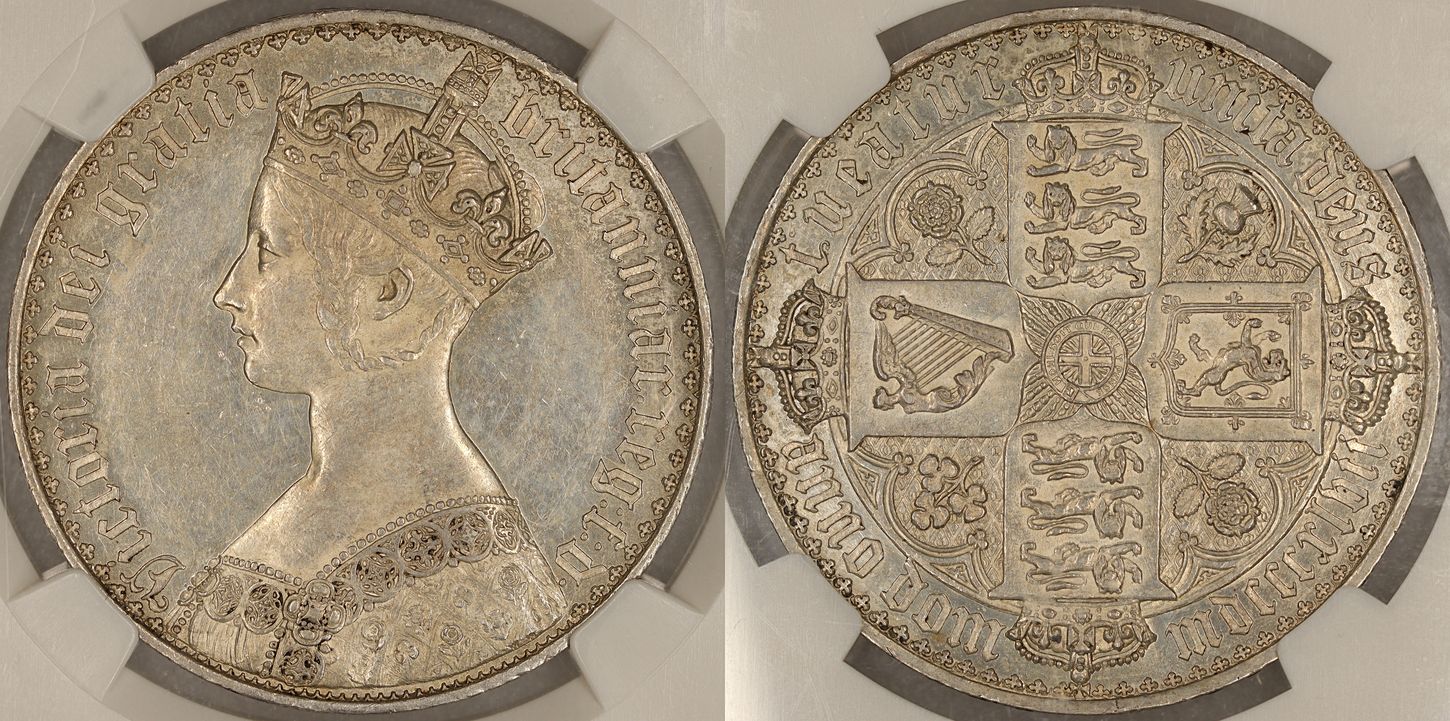
Victoria of the House of Hanover, Queen of the United Kingdom 1837-1901 AD, Silver Crown, 1847, ‘Gothic’ Type, undecimo Edge. Obverse: Crowned ‘Gothic’ style bust of Queen Victoria facing to left, legend around, “Victoria Dei gratia britanniar. reg: f:D·”. Reverse: Crowned cruciform shields of arms of the United Kingdom, national floral emblems in angles framed with tressure of arches and ornate lattice, “W” incuse either side of top crown, legend around, “tueatur unita Deus Anno Dom mdcccxlvii”. Edge: Inscription in raised lettering, “decus et tutamen anno regni undecimo”. Spink-3883. Certified and Graded by NGC as PF58. Few minor hair lines to obverse field, forcing a lower grade by NGC, despite this, however, detail is still quite charming and the reverse is virtually problem free and attractive.

Pamphylia, Side, Silver Stater of Two Siglos (10.72g, 20mm, Persian Standard), struck circa 460-430 BC. Obverse: Pomegranate within dot-and-cable border. Reverse: Head of Athena facing right wearing raised, un-crested Corinthian helmet, earring and necklace, all within incuse square. SNG von Aulock 4762; SNG France 628-9. Well centred with the obverse typically weakly struck, an attractive offering. Good Very Fine.

United States of America, Silver ‘Peace’ Dollar dated 1928, Philadelphia mint. Obverse: Radiate Capped Head of Liberty facing to left, “IN GOD WE TRUST” below, “LIBERTY” above. Reverse: Eagle standing facing to right on rock, wings folded with branch in talons, rays behind, “PEACE” below, denomination “ONE DOLLAR” either side, legend above “UNITED STATES OF AMERICA E PLURIBUS UNUM”. KM-150. Key date. Near Uncirculated.

Sicily, Himera, Æ Hemilitron (12.49g, 23mm), struck circa 430-420 BC. Obverse: Gorgoneion, the head of Gorgon, facing forward. Reverse: Six pellets at centre to mark the value. Seaby-1105; Calciati vol I, Himera-24; HGC 2, 472. Attractive dark brown patina, well centred on obverse with no encrustation or corrosion; scarce type and even scarcer in grade. Likely some smoothing in the past, typically seen on bronzes; otherwise likely one of the finest known. In recent times, one other sold by Roma Numismatics Ltd. Hammered for 440 GBP (approx. AU$1000 with buyer’s premium). Good Very Fine or better.

Augustus, Roman Emperor from 27BC – 14 AD, Silver Denarius (3.71g, 18mm), struck at Lugdunum 11-10 BC. Obverse: Laureate Head of Augustus facing right, legend around, “AVGVSTVS DIVI·F”. Reverse: Bull butting right, “IMP· XII” in exergue. Similar to Sear-1610; RIC.I-176a; RSC-153. Bankers mark to jaw and minor graffiti to lower right field on obverse, otherwise an attractive bust. Good Very Fine / Very Fine.

Caracalla, Roman Emperor from 198-217 AD, Silver Tetradrachm (15.64g, 27mm) of Seleucis and Pieria, Provincial issue, struck at Antiochia ad Orontem 213-217 AD. Obverse: Laureate Head of Caracalla facing to right, legend around, “AVT K M A ANΤѠNЄINOC CЄB”. Reverse: Eagle stands facing forward, head turned to right, holding wreath in beak, star below, legend around, “ΔHMAPX ЄΞ VΠATOC TO Δ”. Sear-2650; Prieur-233; McAlee-686. An attractive silver piece featuring the archetypically bold portraiture of the Syrian mints, good Very Fine / Very Fine.
Colonial Column: Highlights of November 2021:
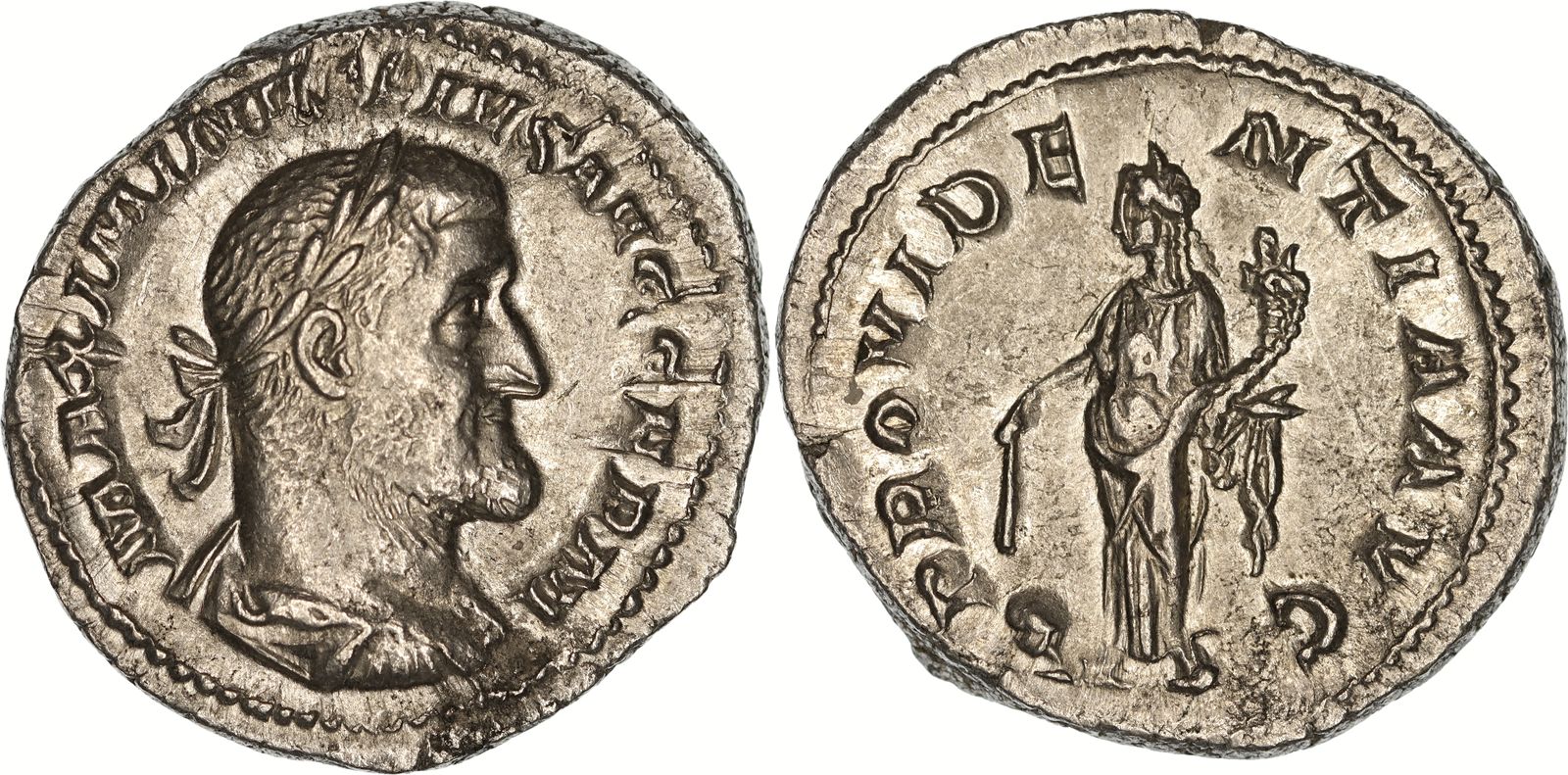
Maxinimus I ‘Thrax’, Roman Emperor from 235-238 AD, Silver Denarius (3.29g, 19.5mm), struck at Rome 236-238 AD. Obverse: Laureate and draped Bust of Maximinus Thrax facing to right, legend around, “MAXIMINVS PIVS AVG GERM”. Reverse: Draped figure of Providentia standing facing to left, holding wand in right hand over globe set on ground and cornucopiae in left hand, legend around, “PROVIDENTIA AVG”. RIC-20. Well centred with the archetypically styled portrait of Maximinus I. Extremely Fine.
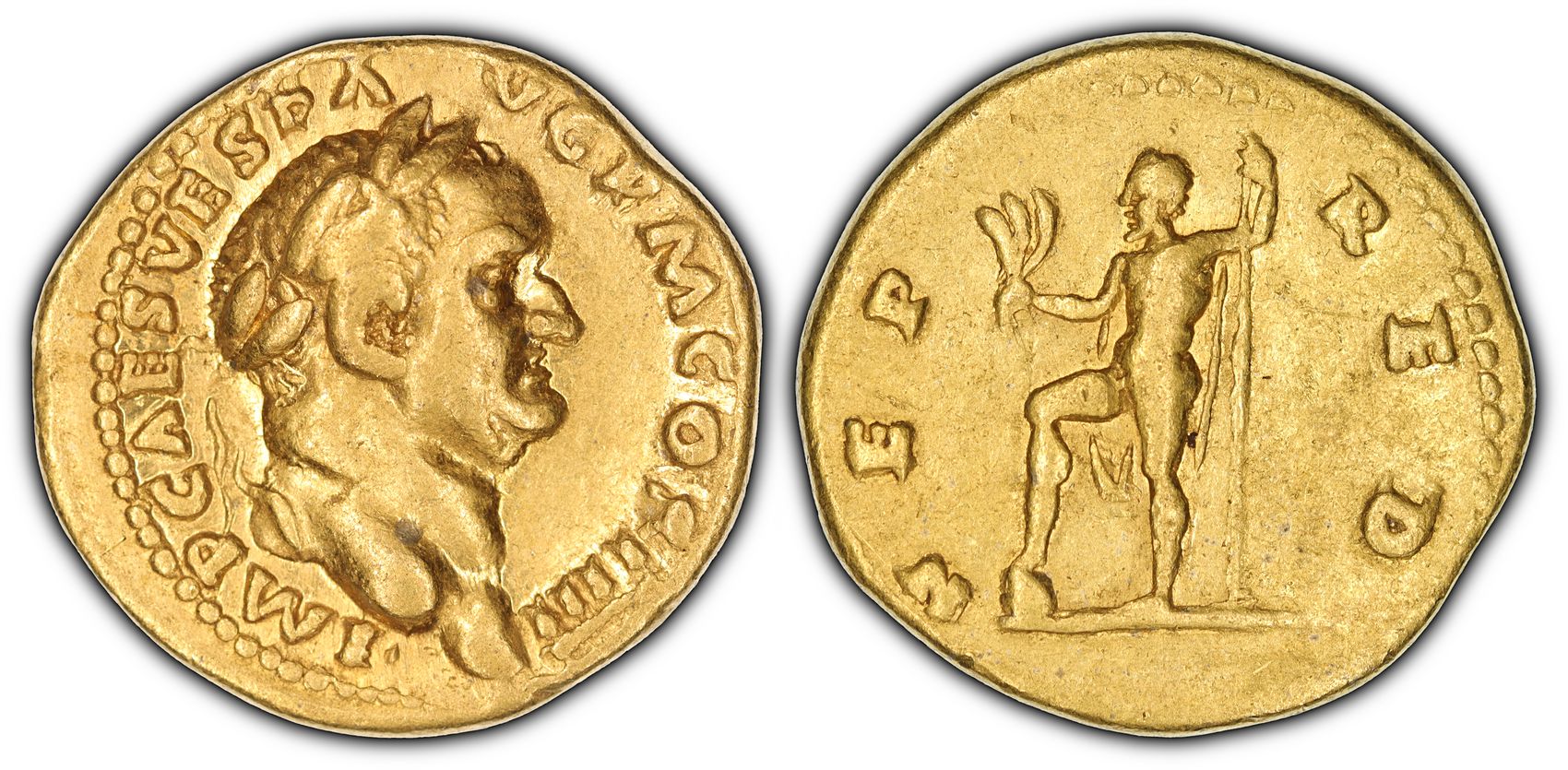
Vespasian, Roman Emperor from 69-79 AD, Gold Aureus (7.17g, 19mm), struck at Rome 72-73 AD. Obverse: Laureate Head of Vespasian facing to right, legend around, “IMP CΛES VESP ΛVG PM COS IIII”. Reverse: Naked figure of Neptune stands to left with right foot on globe, holding acrostolium in right hand and long sceptre in left, legend around, “NEP RED”. RIC-358; Cohen-273; Calicó-654. An attractive, lustrous Aureus in a modest, collectible grade; Vespasian is portrayed in faithful Flavian style with archetypically angular facial features, a bold style repeated by both Titus and Domitian. Near Very Fine or better.
The Obverse Latin legend reads “Imperator Caesar Vespasianus Augustus, Pontifex Maximus, Consular Quartum”, with an English translation of “Imperator Caesar Augustus Vespasianus Augustus, Chief High Priest of the College of Pontiffs, Consul in his fourth term”. The Reverse Latin legend reads “Neptune Redux”, with an English interpretation of “Neptune, he who returns the Emperor from the sea safely”. Neptune was the Roman god of fresh water and the sea and was the Roman interpretation of the Ancient Greek god Poseidon.

Macedonian Empire, the Alexandrine Era, Alexander III ‘the Great’, King of Macedon 336-323 BC, Gold Stater (8.43g, 17mm, Attic Standard), Posthumous issue, struck at Miletus circa 300-295 BC, likely under the authority of Lysimachus as King of Asia Minor and Thrace. Obverse: Head of Athena facing to right, wearing crested Corinthian helmet ornamented with a coiled snake. Reverse: Draped Figure of Nike standing forward with wings spread, her head facing to left, holding laurel wreath in outstretched right hand and stylis in her left; helmet-crest symbol to left field, double-axe symbol below left wing, “ΑΛΕΞΑΝΔΡΟΥ” to right. Price-2135. Some unfortunate scratches to reverse, otherwise well centred and with a charming obverse. Good Very Fine to near Extremely Fine.

Boer War and World War I group of 4 to the Hampshire Regiment, then the Royal Artillery
Queen’s South Africa Medal (Type II with ‘Ghost Dates’), Clasps: CAPE COLONY, PAARDEBERG, JOHANNESBURG. Impressed to “5201 PTE A. OSMOND. 2: HAMPSHIRE: REGT”
King’s South Africa Medal, Clasps: SOUTH AFRICA 1901, SOUTH AFRICA 1902. Impressed to “5201 CPL. A.E.L. OSMOND 2/HANTS. REGT”
British War Medal & Victory Medal, each impressed “22943 SJT A.E.L. OSMOND R.A.”.
Lacking in service details and requires research. Extremely Fine
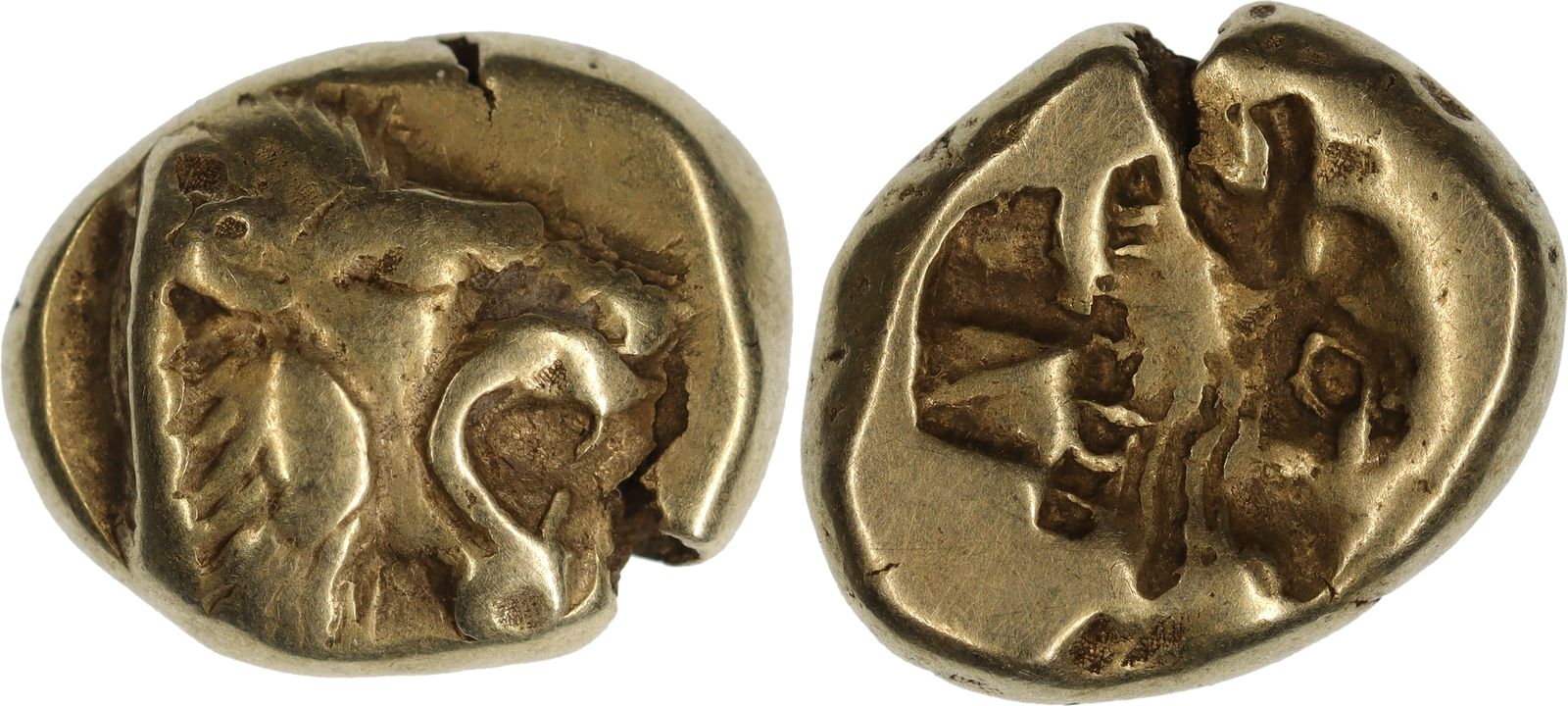
Lesbos, Mytilene, Electrum Hekte – Sixth of a Stater (2.51g, 11mm, Chian Standard), struck circa 521-478 BC. Obverse: Roaring Lion facing right. Reverse: Incuse Calf Head facing right. Bodenstedt-13; SNG Copenhagen-301. Minor flan crack, otherwise well centred on an oval flan – nice obverse. Good Fine to about Very Fine.
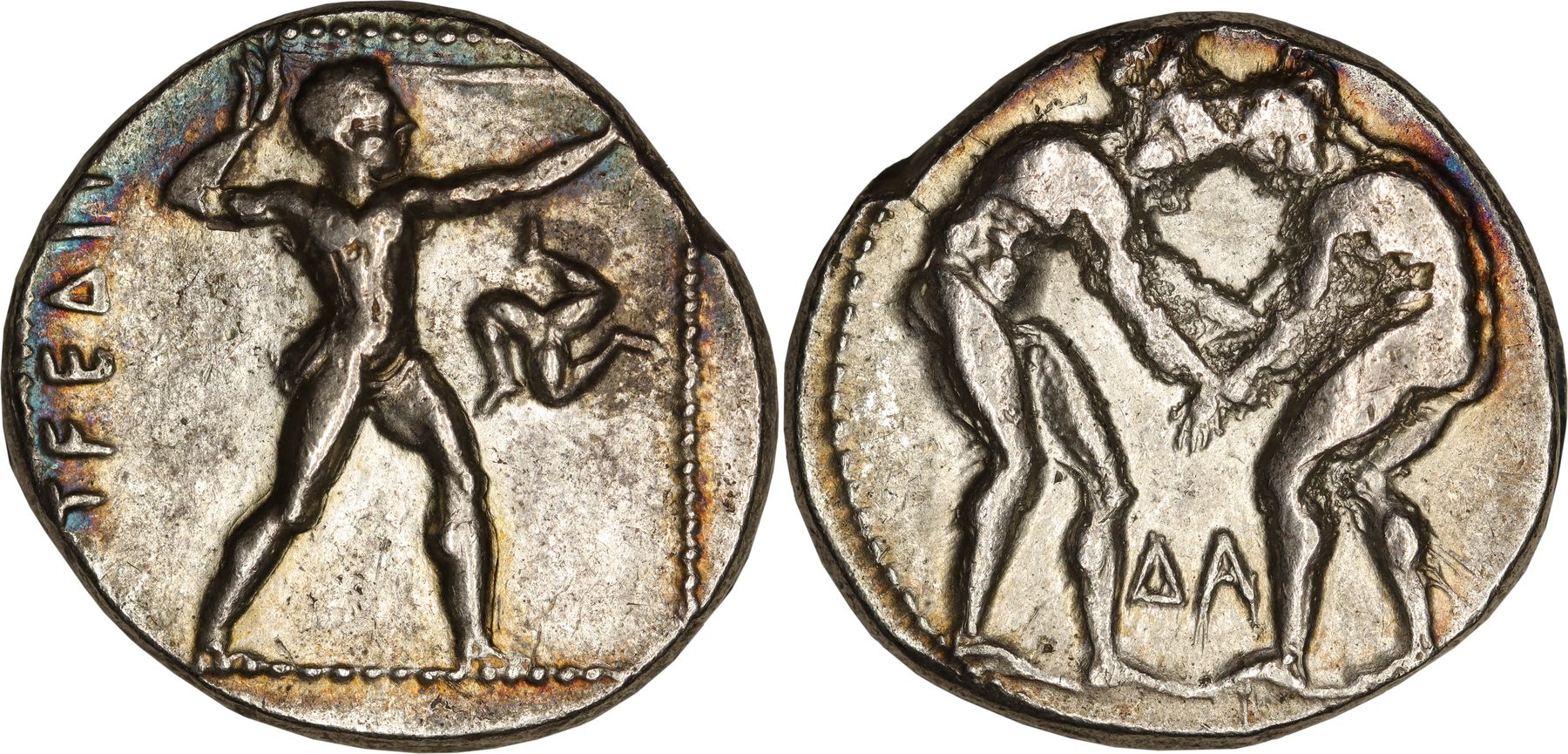
Pamphylia, Aspendos, Silver Stater of Two Siglos (10.89g, 22mm, Persian Standard), struck circa 400-370 BC. Obverse: Two naked wrestlers grappling, “ΔA” below. Reverse: Slinger, wearing short chiton, discharging sling right, clockwise triskeles of human legs to right, “EΣTFEΔIIYΣ” to left. Some lovely toning and well centring, unfortunately struck with some rusty dies on the obverse. Near Extremely Fine.
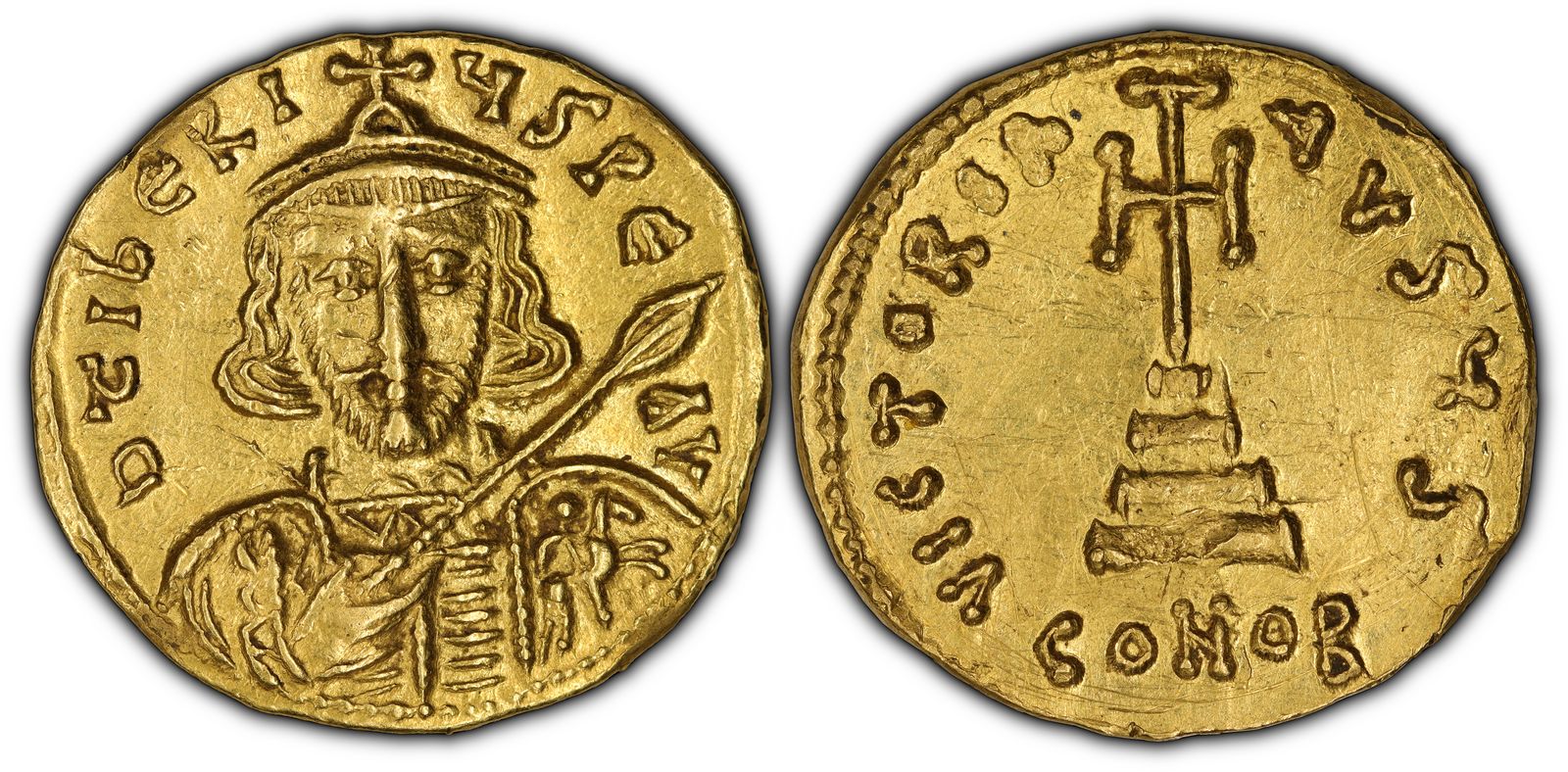
Tiberius III ‘Apsimar’, Byzantine Emperor from 698-705 AD, Gold Solidus (4.39g, 20mm), struck at Constantinople mint. Obverse: Crowned and cuirassed bust of Tiberius III facing forward, his beard short, wielding shield and spear, legend around, “D tIbЄRIЧS PЄ AV”. Reverse: Cross Potent set on three steps, legend around, “VICTORIA AVςЧ S”, “COBOB” in exergue. Sear-1360. Unfortunate reverse graffiti, otherwise a quite attractive and choice obverse; a somewhat scarcer Byzantine type struck during the 20-year military anarchy. Details Extremely Fine / about Extremely Fine.
This gold Solidus of Tiberius III ‘Apsimar’ was struck during ‘the Twenty Years’ Anarchy’, a term used by modern scholars that refers to the time between the deposition of Emperor Justinian II in 695 to the ascent of Leo III ‘the Isaurian’ and the beginning of the Isaurian Dynasty in 717. The obverse Latin legend reads “Dominus Tiberius Perpetuus Augustus”, translating to “Lord Tiberius, Perpetual Augustus”. The reverse Latin legend reads “Victoria Augustorum” followed by the 6th officina letter “S”, translating to “Victory of the Augusti”.

Turkey, World War I (1914-1918), ‘Harp Madalyası’ or ‘Gallipoli Star’ dated AH1333 (1914-1915 AD), Enamelled Version, awarded to Officers, German craftsmanship by “B.B. + Co” (marked on back). Obverse: Red enamel star, Turkish Crescent surrounds Tughra, dated AH1333 below. Reverse: shaped as obverse, plain surface with wearing pin, “B.B. & Co”. An exceptional example with virtually perfect, intact enamel – seldom seen in such a preserved standard. Extremely Fine.

George III, King of Great Britain 1760-1820 AD, Silver Threepence dated 1762, Early Coinage. Obverse: Laureate, cuirassed and draped bust of King George III facing right, legend around, “GEORGIVS· III· DEI· GRATIA·”. Reverse: Denomination “3” crowned, legend around, “MAG· BRIT· FR· ET· HIB· REX· 1762·”. Spink-3753. Certified and Graded by PCGS as Mint State 62 (#38243804). Before encapsulation this piece was developing some nice purple tone between 10-1h. A sharp reverse.

George III, King of the United Kingdom 1760-1820 AD, Silver Shilling dated 1817. Obverse: Laureate Head of King George III facing right, “GEOR: III D:G: BRITT: REX F:D: 1817”. Reverse: Crowned Shield of Arms of the United Kingdom (1816-1837) within ornate mantle, garter surrounds bearing the motto “HONI· SOIT· Q MAL· Y· PENSE·”. Spink-3791; Bull-2195; Esc-1632. Visually appealing, original grey toning. Almost Uncirculated.

George III, King of the United Kingdom 1760-1820 AD, Silver Sixpence dated 1816. Obverse: Laureate Head of King George III facing right, “GEOR: III D:G: BRITT: REX F:D: 1817”. Reverse: Crowned Shield of Arms of the United Kingdom (1816-1837) within ornate mantle, garter surrounds bearing the motto “HONI· SOIT· Q MAL· Y· PENSE·”. Spink-3791; Bull-2195; Esc-1632. Visually appealing, bright argentum appearance. Almost Uncirculated.

Queen Elizabeth II (1952-present), Ten Dollar star banknote last-prefix, ‘Commonwealth of Australia’, signed by Reserve Bank Governor H.C. Coombs and Secretary of the Treasury Richard J. Randall, issued in 1967. Serial Number ZSE 42942*. Renniks-302SL. Scarce star last prefix note. Very Fine.
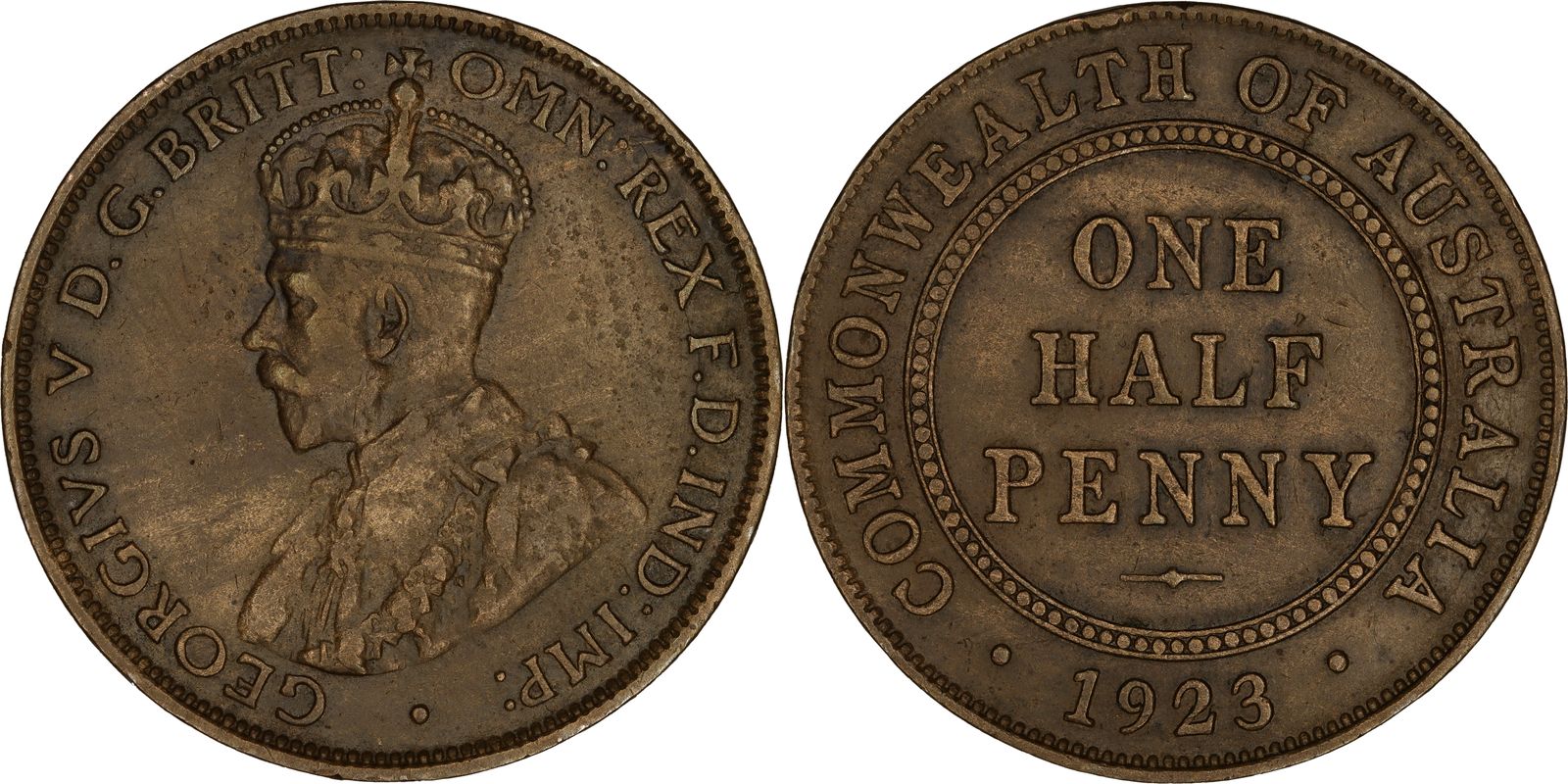
King George V (1910-1936 AD), Æ Half Penny, 1923, Melbourne mint. Obverse: Crowned Bust of George V facing right, legend around, “GEORGIVS V D.G. BRITT: OMN: REX F.D. IND: IMP:”. Reverse: Denomination “ONE HALF PENNY” above small scroll all within beaded inner circle, “COMMONWEALTH OF AUSTRALIA 1923”. Key date of the series, attractive and problem free. About Very Fine / Very Fine.

C.Egnatius Cn.f. Cn.n. Maxsumus (Maximus), Moneyers of the Roman Republic, Silver Denarius (3.94g, 19mm), struck at Rome 75 BC. Obverse: Diademed Head of Libertas facing right, Pilleus to left field, “MAXSVMVS” to left. Reverse: Togate figures of Roma and Venus standing facing forward, Roma (left) holds a spear and sword with her left foot set on a wolf’s head, Venus (right) holds a sceptre with Cupid alighting on her shoulder, rudder set on prow either side, “CNN” to right, “C EGNATIVS CN F” (“AT” as monogram) in exergue. Sear-326, RSC Egnatia-2. Very Fine / About Very Fine, semi scarce type.

Julius Bursio, Moneyers of the Roman Republic, Silver Denarius (3.94g, 19mm), struck at Rome 85 BC. Obverse: Laureate, winged and draped Bust of Vejovis facing right, Trident above control mark to left field. Reverse: Winged Victoria commands Quadriga to right, “L· IVLI· BVRSIO” in exergue. Sear-268. Choicely centred and evenly worn, an honest, toned example for the type. Near Very Fine.
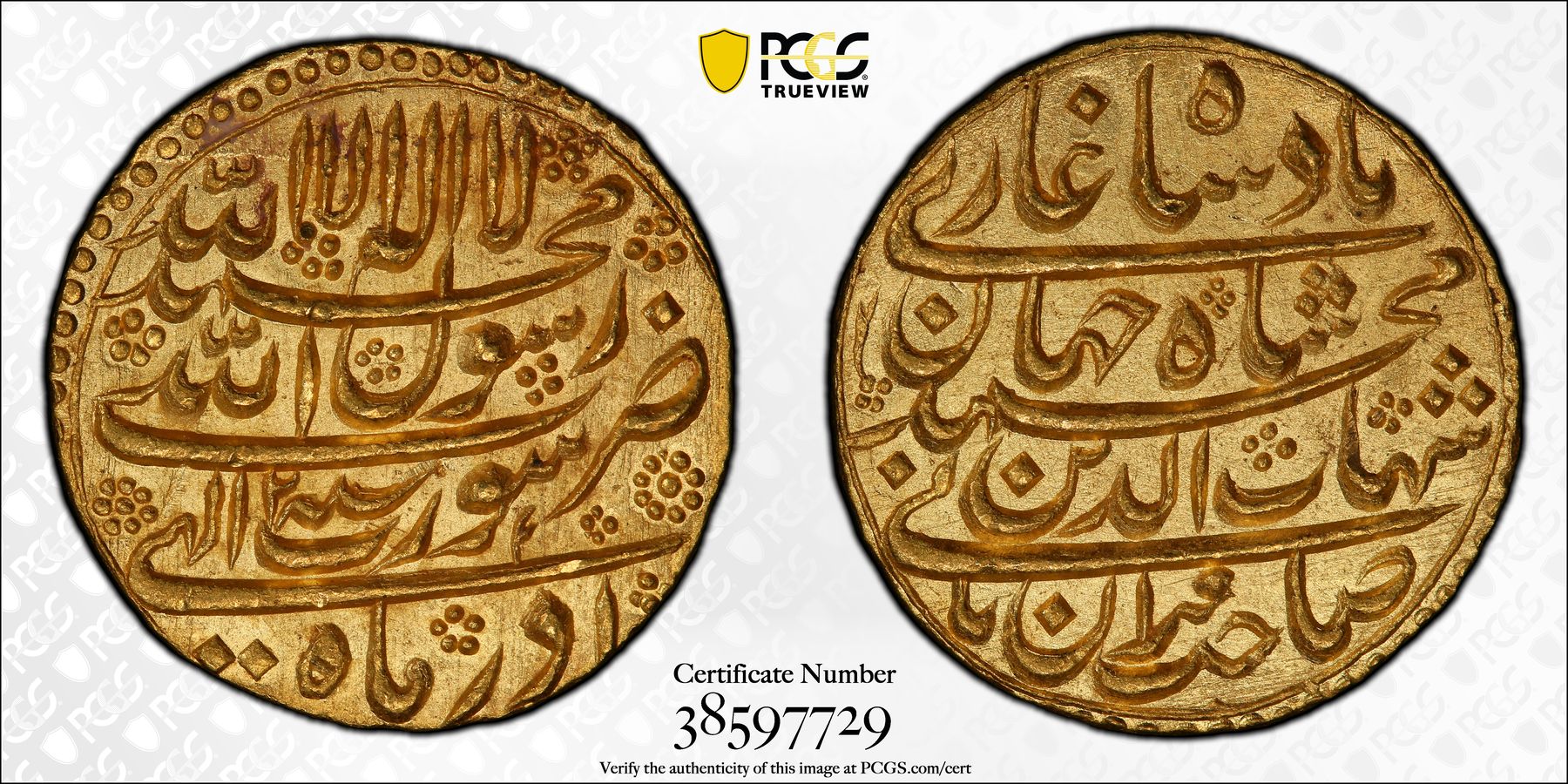
Mughal Empire, Muhammad Shah, Mughal Emperor 1719-1748 AD, Gold Mohur (10.88g) dated AH11xx, Regnal Year 19 (1736-1737 AD), struck at Shahjahanabad (Delhi). KM-439.4. Certified and Graded by PCGS as Mint State 65 (#38597730).
Dazzling in its preservation, this superb gem reveals glowing Aurum lustre at every angle, the appeal further bolstered by virtually flawless, smooth satiny surfaces to both obverse and reverse that sets the scene for the exceptional detail – a result of finely engraved dies coupled with bold striking. It stands tall at the peak of regnal year 19 mohurs, being the single finest graded example by PCGS and certainly one of the finest we’ve seen on the numismatic retail market of recent times. Current 2021 auctions results on coinarchives reveal only one of similar grade and visual quality, this piece was sold by Stephen Album Rare Coins, a year 30 Shahjahanabad Mohur, and hammered for US$1800, which with buyer’s premium is US$2160 or AU$2880. Their piece is a gem example with lovely centring, being graded PCGS Mint stage 64, and showcases an obverse that possibly rivals the coin we offer here. However, we feel that our piece offered here features better striking and nicer surfaces and, in our opinion, a more visually appealing and nicer coin, a notion that is corroborated by a higher PCGS grade.
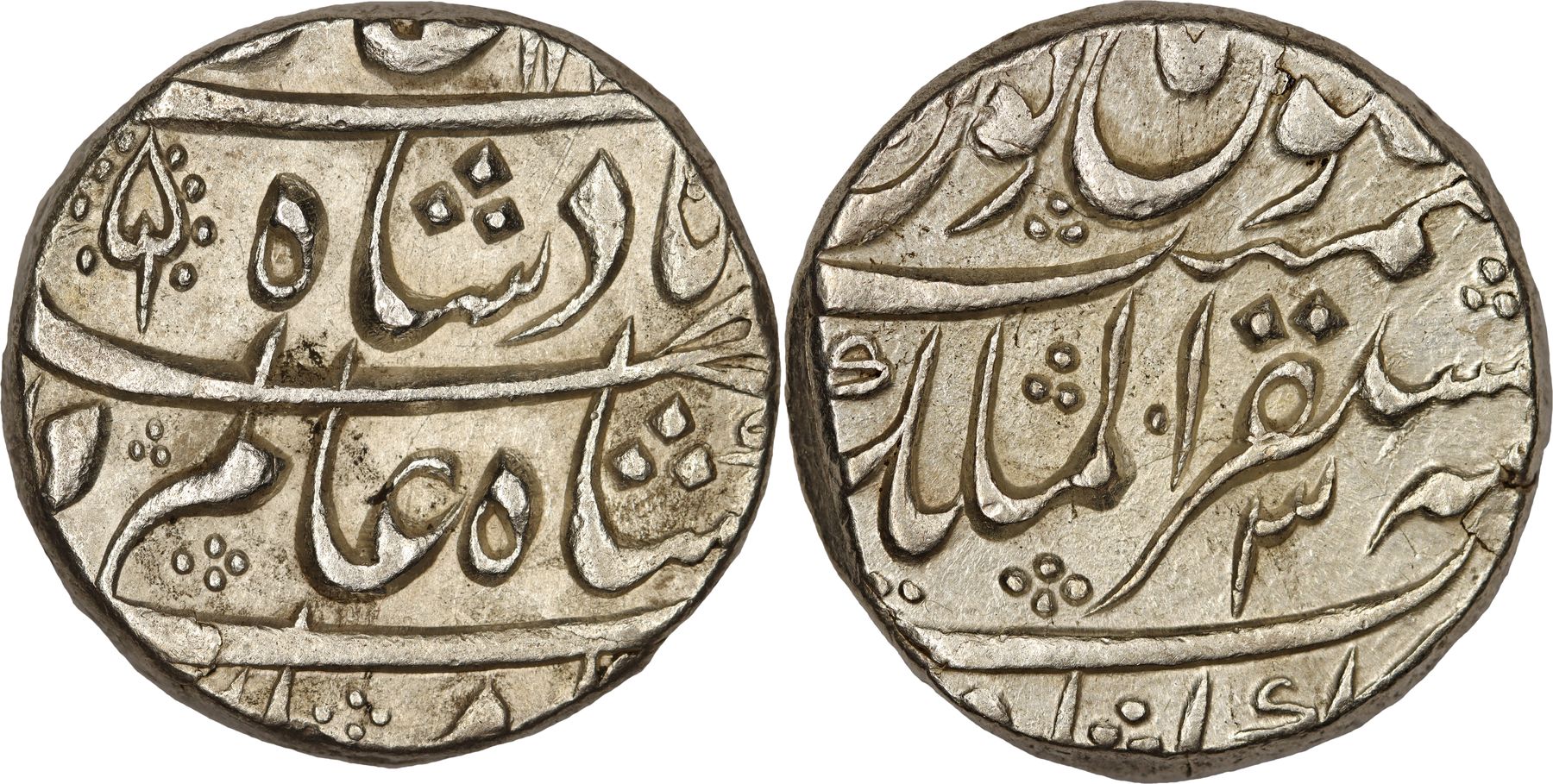
Mughal Empire, Shah Alam Bahadur, Mughal Emperor 1707-1712 AD, Silver Rupee dated AH 1121 Regnal Year 3 (1709-1710 AD), struck at Akbarabad mint (Mustaqir al Khilafa). Obverse: Legend ‘sikka mubarak badshah ghazi’, naming the emperor and Hijiri year. Reverse: Legend ‘sanah 3 julus zarb mustaqir-ul-mulk’, naming the Regnal Year and mint name. Although the date is largely off flan, it is easily deduced from the Regnal Year. Lovely surfaces and boldly struck. Good Extremely Fine / Extremely Fine, obverse better.

Queen Elizabeth II (1952-present), Æ Proof Penny dated 1960 Y., Perth mint. Obverse: Laureate Bust of Elizabeth II facing right, legend around, “+ ELIZABETH· II· DEI· GRATIA· REGINA· F:D:”. Reverse: Kangaroo in motion to left, date to right, legend around, “AUSTRALIA PENNY”. KM-56. Toning slightly. About Fleur de Coin.
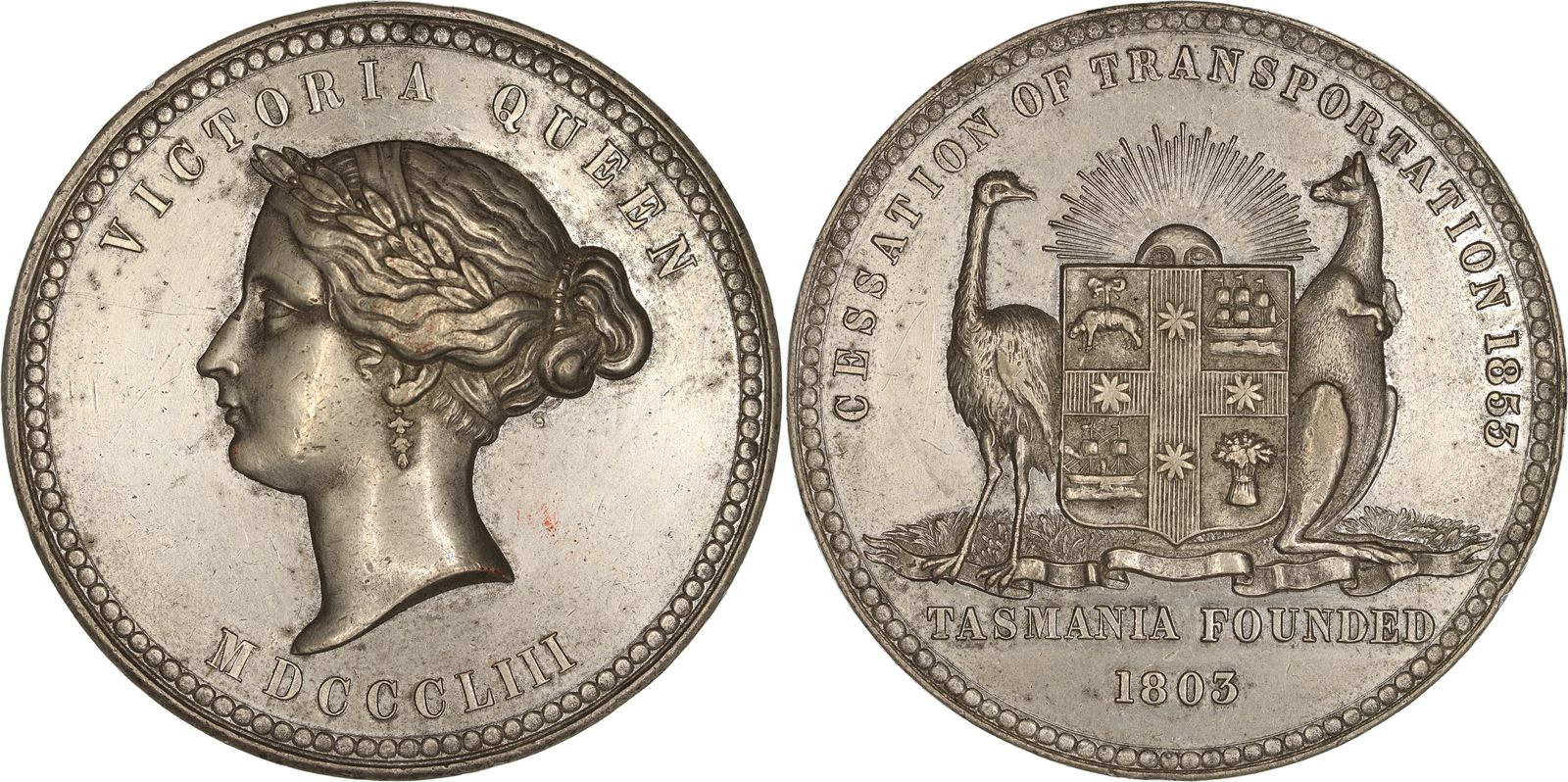
Tasmania, ‘Cessation of Transportation to Tasmania’ Commemorative Medallion (58mm) in White Metal, dated 1853, struck at the Royal Mint, London. Obverse: Laureate Head of Queen Victoria facing left, her hair single filleted and collected in an updo knot, legend around, “QUEEN VICTORIA / MDCCCLIII”. Reverse: Coat of Arms at centre, legend above, “CESSATION OF TRANSPORTATION 1853”, “TASMANIAN FOUNDED 1803” in exergue. Carlisle-1853/2. An imposing medallion of historical significance. Minor edge bump to4h reverse. Good Very Fine or better.
Colonial Column: Highlights of December 2021:

Kingdom of Portugal, John V ‘the Magnanimous’, King of Portugal 1706-1750 AD, Gold 800 Reis or 1/16 Johanna (1.72g, 17mm) dated 1730, Lisboa mint. Obverse: Laureate Head of King John V facing to right, date below, legend around, “IOANNES. V. D.G. PORT. ET. ALG. REX”. Reverse: Crowned Shield of Arms of the Kingdom of Portugal within ornate mantle. KM-218. A lovely proclamation fractional, unfortunately ex-mount and with a few hairlines, details good Very Fine.
Although the Gold Johanna and Half Johanna were the chosen money pieces from the Portugeuse Empire mentioned within the Australian Proclamation document of 1800, the fractionals are accepted as part of the ‘wider series’, therefore, within Colonial Australia, the 800 Reis had a theoretical revaluation to Five Shillings.
The Obverse Latin legend reads “Joannes Quintus, Dei Gratia, Portucale et Algarve Rex”, which has an English translation of “John the Fifth, by the Grace of God, King of Portugal and Algarve”.

Henry VI of the House of Lancaster, King of England in his First Reign 1422-1461 AD, Silver Groat of Four Pence (3.70g, 26mm), Annulet Issue (1422-1427 AD), Calais mint, mintmark Pierced Cross. Obverse: Crowned Bust facing forward within tressure of arches, Lis at each cusp, annulets by neck, beaded border and legend around, “ҺЄꞂRIC⨯ DI GRΛ⨯ RЄX ΛꞂGL⨯ Ƶ⨯ FRΛꞂC”. Reverse: Long Cross Pattée, trio of pellets in each inner angle with annulet in first and third, beaded border and inner legend arround “VIL LΛ CΛLI SIЄ”, second beaded border and outer legend surrounds, “POSVI◦ DЄVᙏ ΛDIVTOR Є⨯ ᙏЄVᙏ”. Spink-1836; North-1427. Flat in parts, otherwise present details Very Fine.
The Obverse Latin legend reads “Henricus, Dei Gratia, Rex Angliae et Franciae”, with an English translation of “Henry, by the Grace of God, King of England and of France”. The Reverse Latin legend reads “Posui Deum Adjutorem Meum, Villae Calesie”, with an English translation of “I have made God my helper, City/Town of Calais”.
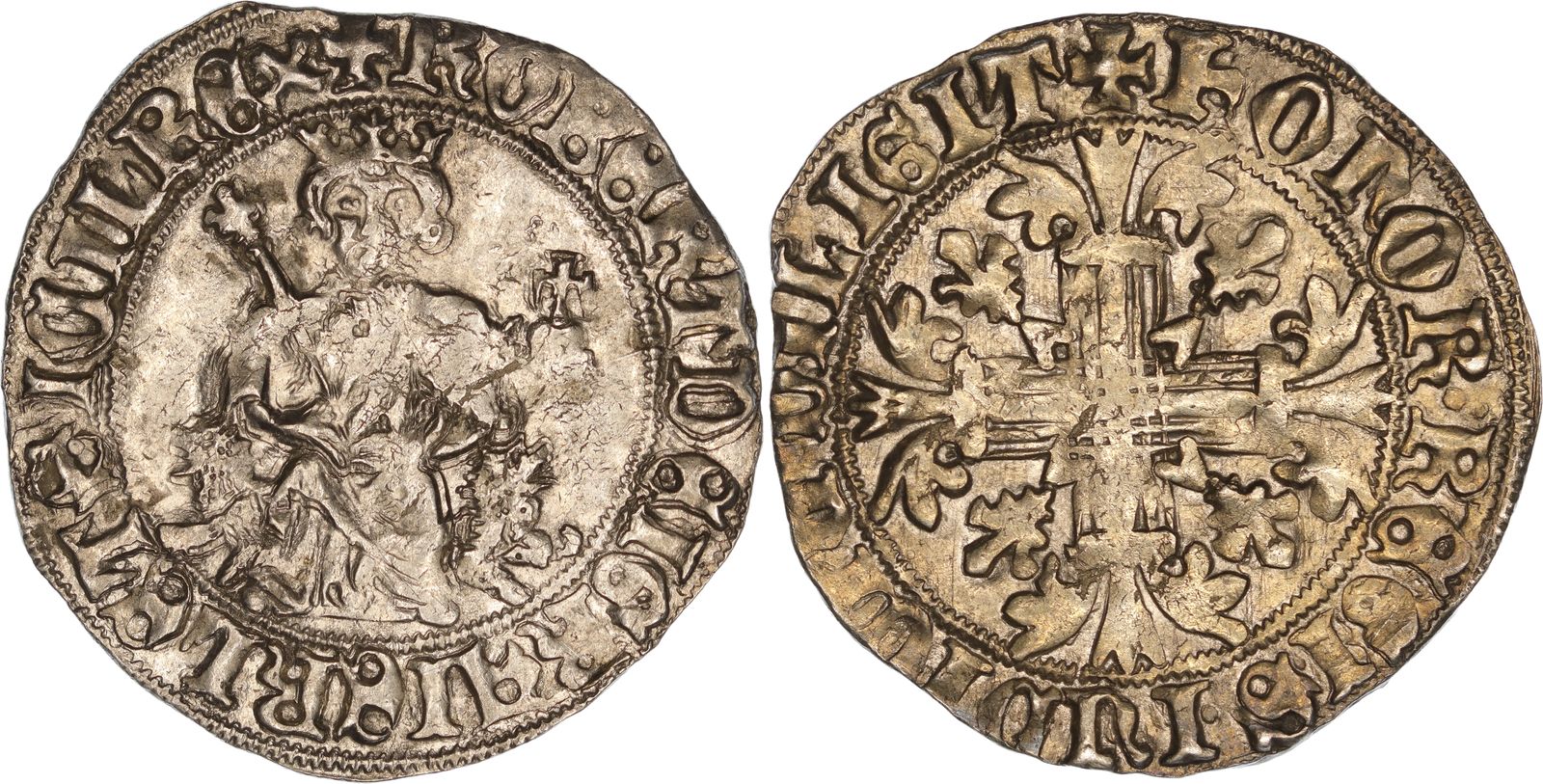
Italy, Kingdom of Naples, King Roberto d’Angiò (1309-1343 AD), Silver Gigliato (3.99g, 27mm), struck 1309-1317 AD. Obverse: Crowned and draped figure of King Roberto d’Angiò facing forward, holding sceptre and globus cruciger, lion lies behind, beaded border and legend around, “ROBЄRT DЄI GRA IЄRL ЄT SICIL RЄX”. Reverse: Small cross fleurey at centre, Lis in each quarter, beaded border and legend around, “hONOR· RЄGIS· IUDICIU· DILIGIT”. MIR-28. An attractive example of Italian hammered coinage. Very Fine or better.
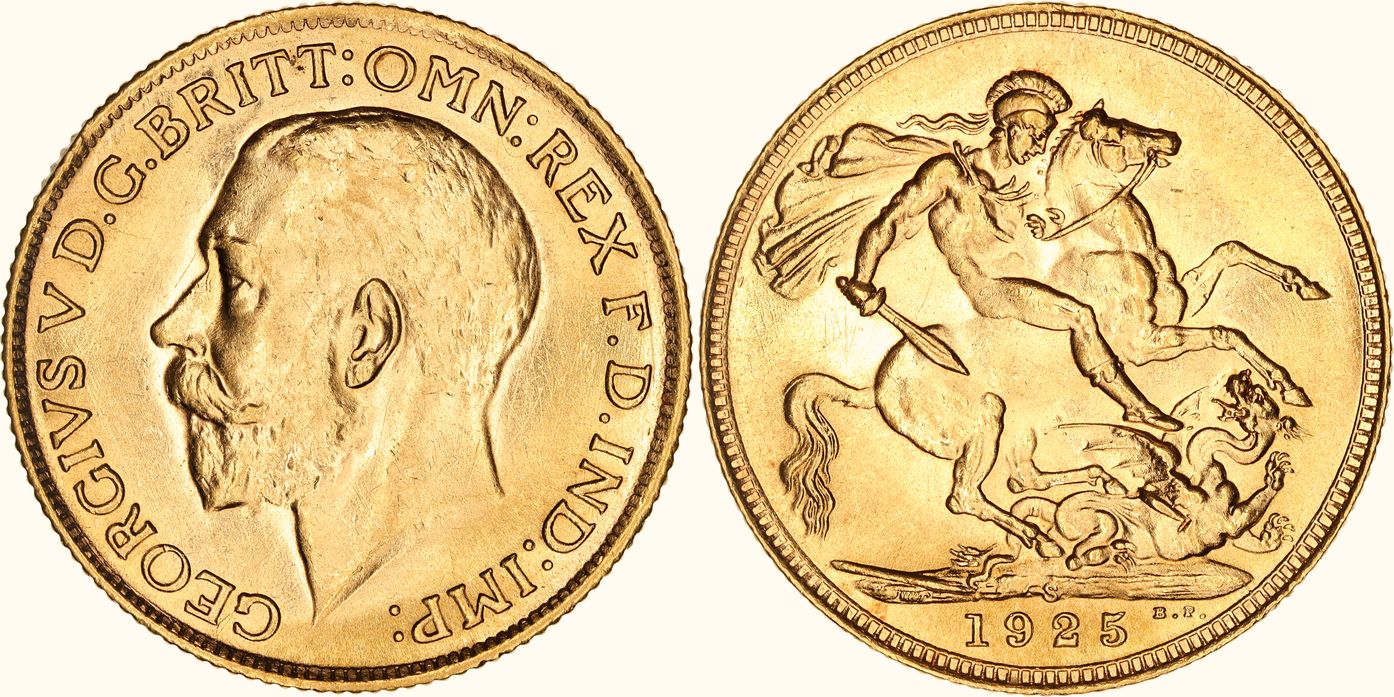
Australia, King George V (1910-1936 AD), Gold Sovereign (7.98g, 22mm) dated 1925 S, Sydney mint. Obverse: Bare Head of King George V facing to left, engraver’s initials ‘B.M.’ (Edgar Bertram Mackennal) on truncation in relief, legend around, “GEORGIVS V D.G. BRITT: OMN: REX F.D. IND: IMP:”. Reverse: Figure of Saint George slaying the Dragon to the right atop horse with a longer tail, wielding sword and wearing plumed helmet and billowing cloak, broken lance to left on exergual line above mint master’s initials ‘wwp’ (William Wellesley Pole), mintmark at centre of exergual line, small engraver’s initials ‘B.P.’ (Benedetto Pistrucci) and date in exergue. Bentley-741; McDonald-279; Marsh-285 S; Friedberg-38; Spink-4003; KM-29. Calendar year mintage 5,632,000. Few minor hair lines to obverse, otherwise virtually as made, the reverse with notable luster and satiny surfaces, Mint State.
The Obverse Latin legend reads “Geōrgius Quīntus, Deī Grātiā, Britanniārum Omnium Rēx, Fideī Dēfēnsor, Indiae Imperātor”, with an English translation of “George the Fifth, by the Grace of God, King of all the British People, Defender of the Faith, Emperor of India”.

Nerva, Roman Emperor from 96-98 AD, Silver Denarius (3.57g, 18mm), struck at Rome 96-98 AD. Obverse: Laureate Head of Nerva facing right, legend around, “IMP NERVA CAES AVG P M TR POT II”. Reverse: Assortment of priestly emblems, including simpulum, aspergillum, guttus, and lituus, legend around, “COS III PATER PATRIAE”. RIC-34; RSC-51. A well centred, problem free example that features a captivating portrait of the first of the ‘Five Good Emperors’. About Extremely Fine / Very Fine, obverse better.
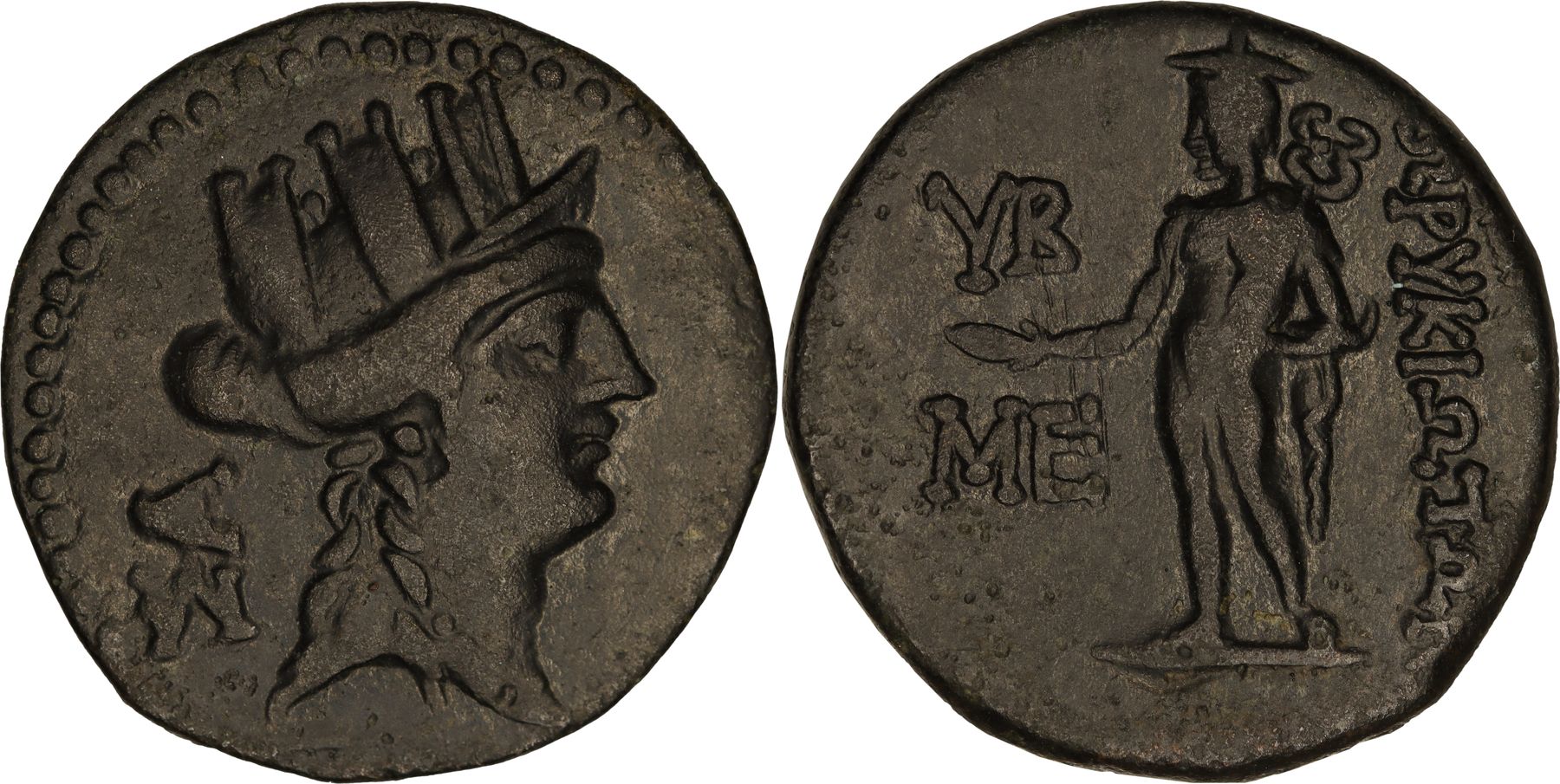
Cilicia, Korykos, Æ Unit (6.63g, 22mm), struck circa 1st Century BC. Obverse: Turreted Head of Tyche, the Goddess of fortune and prosperity, facing right, “ΣA” to left. Reverse: Hermes stands facing left wearing petasos and winged boots and holding patera and caduceus, “KΩPVKIΩTΩN” to right, “YB” above “ME” to left. SNG France II-1094; Paris-486; Ziegler Kiliken-545. Choice obverse. Extremely Fine / Good Very Fine

United Kingdoms, Incorporated Law Society, Bronze Award Medallion (56mm), issued in 1902 to solicitors etc. who served in the Anglo-Boer War. Obverse: Coat of Arms of the Society, legend around, “THE· INCORPORATED· LAW· SOCIETY· OF· THE· UNITED· KINGDOM· 1902·”. Reverse: Legend raised over Crowned rose, “PRESENTED BY THE PRESIDENT OF THE SOCIETY, SIR ALBERT KAYE ROLLIT, LLD C.D.L., M.P., AND THE VICE PRESIDENT, JOHN EDWARD GREY HILL, ESQ. TO SOLICITORS & ARTICLED CLERKS WHO SERVED IN THE SOUTH AFRICAN CAMPAIGN, 1899-1902, AND WHO WERE ENTERTAINED BY THE SOCIETY, AT A BANQUET, IN ITS HALL, ON DECEMBER 18TH, 1902.”. Eimer-1868. A scarce piece. Almost Uncirculated.

World War II, the Rats of Tobruk Medal, number 366, die struck in white metal 1941. “RATS OF TOBRUK 1941”, gilded enamel figure of a Rat at centre surrounded with blue-purple enamel, legend surrounds / uniface, number “366” impressed. Some blue enamel missing, otherwise virtually as made – a very important piece of Australian military history. Virtually as Made, very scarce.

Dutch Republic, the Netherlands, Silver 3 Gulden dated 1793, minted at Utrecht. Obverse: Crowned Escutcheon featuring the Dutch Republic Rampant Lion holding the sword, the Defender, and the seven arrows, representing the Seven United Provinces of the Netherlands, centred between the denomination “3 GL.”, “MO: ARG: ORD: FŒD: BELG: TRAI.” . Reverse: The Dutch Virgin standing facing forward, spear in her right hand upon which the Cap of Liberty lies, her left arm rests on the Holy Bible which is on an ornamented pillar, date below, “HAC NITIMVR HANC TVEMVR”, date “1793” in exergue. Dav-1852, KM-117. Certified and Graded by NGC as Almost Uncirculated 58 (#4970905). Cabinet toning is greeted by lovely rainbow iridescence along the periphery, giving this coin some great eye appeal. As is usually the case, photography through slabs does not give this piece justice.
Although the Dutch silver One Gulden was the chosen money piece mentioned within the Australian Proclamation document of 1800 by Philip Gidley King, the Governor of New South Wales, the fractionals and higher denominations are accepted as part of the ‘wider series’. Therefore, within Colonial Australia, the silver Three Gulden had a theoretical revaluation to Six Shillings.
The obverse Latin legend reads “Moneta Argentea Ordinum Foederatorum Belgii Traiectum”, translating to “Silver Money of the United Provinces of the Netherlands, Utrecht”. The reverse Latin legend translates to “On her we lean, her we protest”.

Sarawak, British Protectorate, Rajah Charles Brooke (1868-1917 AD), Silver 50 Cents dated 1900 H, minted at Soho, Birmingham. Obverse: Bare Head of Charles Brooke facing left, legend around, “C. BROOKE RAJAH ·SARAWAK·”. Reverse: Value “50” within roped border, legend around, “FIFTY ·1900· CENTS”. KM.11. Light toning. Extremely Fine.
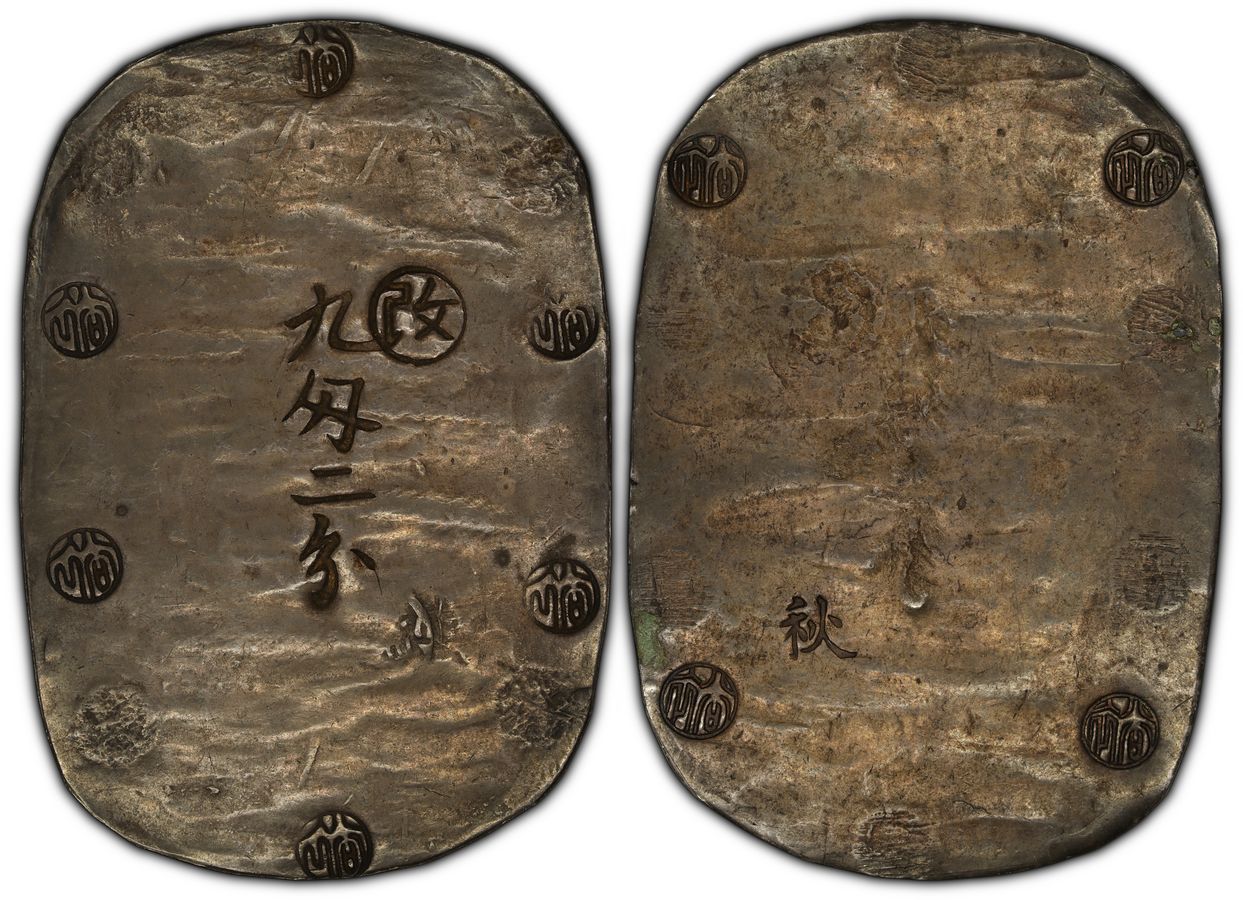
Japan, Edo Period, Bunkyū Era, Silver 9 Momme 2 Fun (34.51g, 81x56mm), struck at Akita circa 1862-1863 AD. Obverse: Vertical stamped characters in the middle naming denomination, with six stamps in seal script around the edge. Reverse: Stamped character at bottom left naming mint, with four stamps in seal script at the corners. KM-12; JNDA-9-71. An exceptional example of this large silver issue with gorgeous tone over the surfaces; strong central stamps and virtually full peripheral impressions only add to the considerable eye-appeal. Extremely Fine or better, very scarce
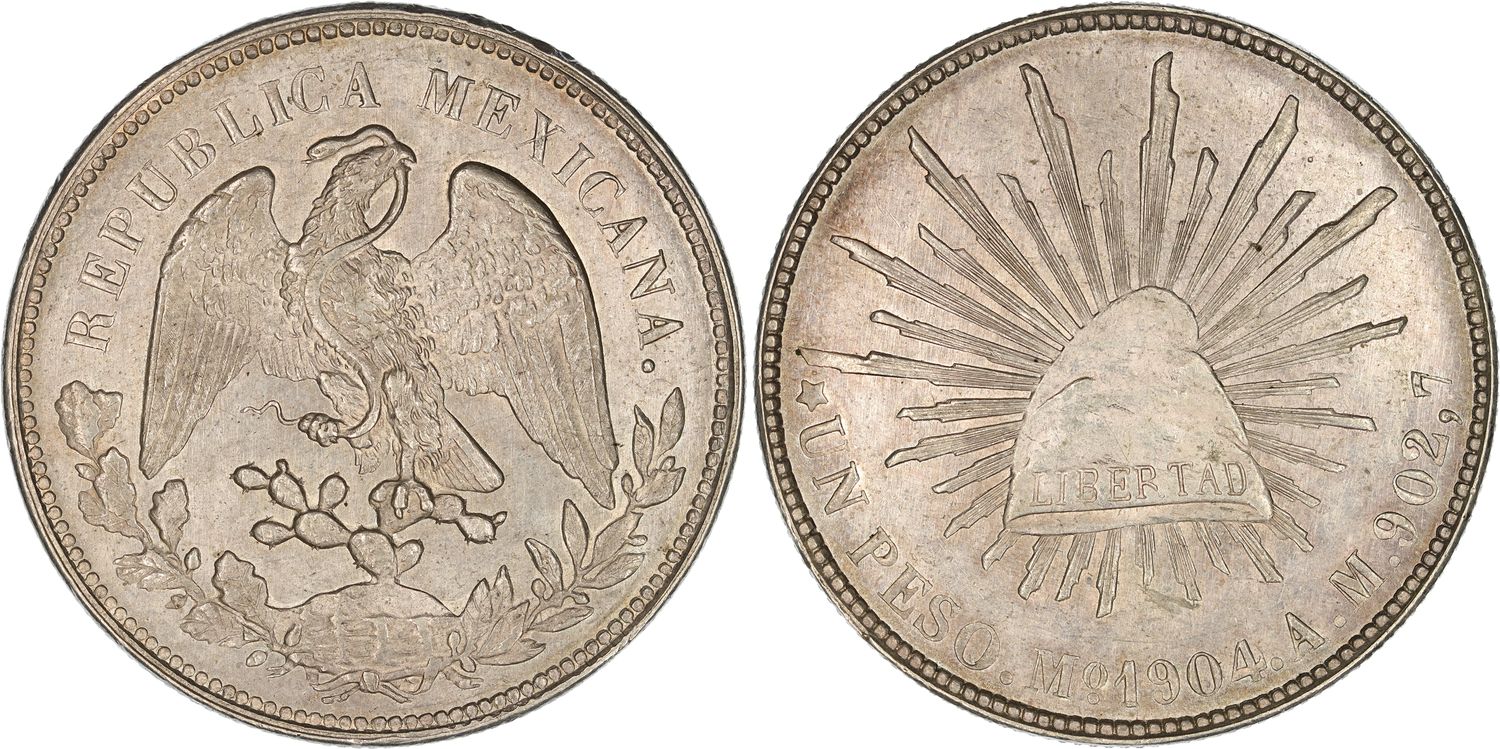
Mexico, Federal Republic, Silver One Peso (27.15g, 39mm) dated 1904 Mo AM, San Francisco mint. Obverse: National arms of Mexico (facing eagle, snake in beak), legend above, “REPUBLICA MEXICANA”. Reverse: Radiant cap with “LIBERTAD” inscription, Value, Mint, Date, Assayer’s initials, and Fineness below. KM-409.2. Nice original toning with attractive underlying brilliance. Near Mint State.
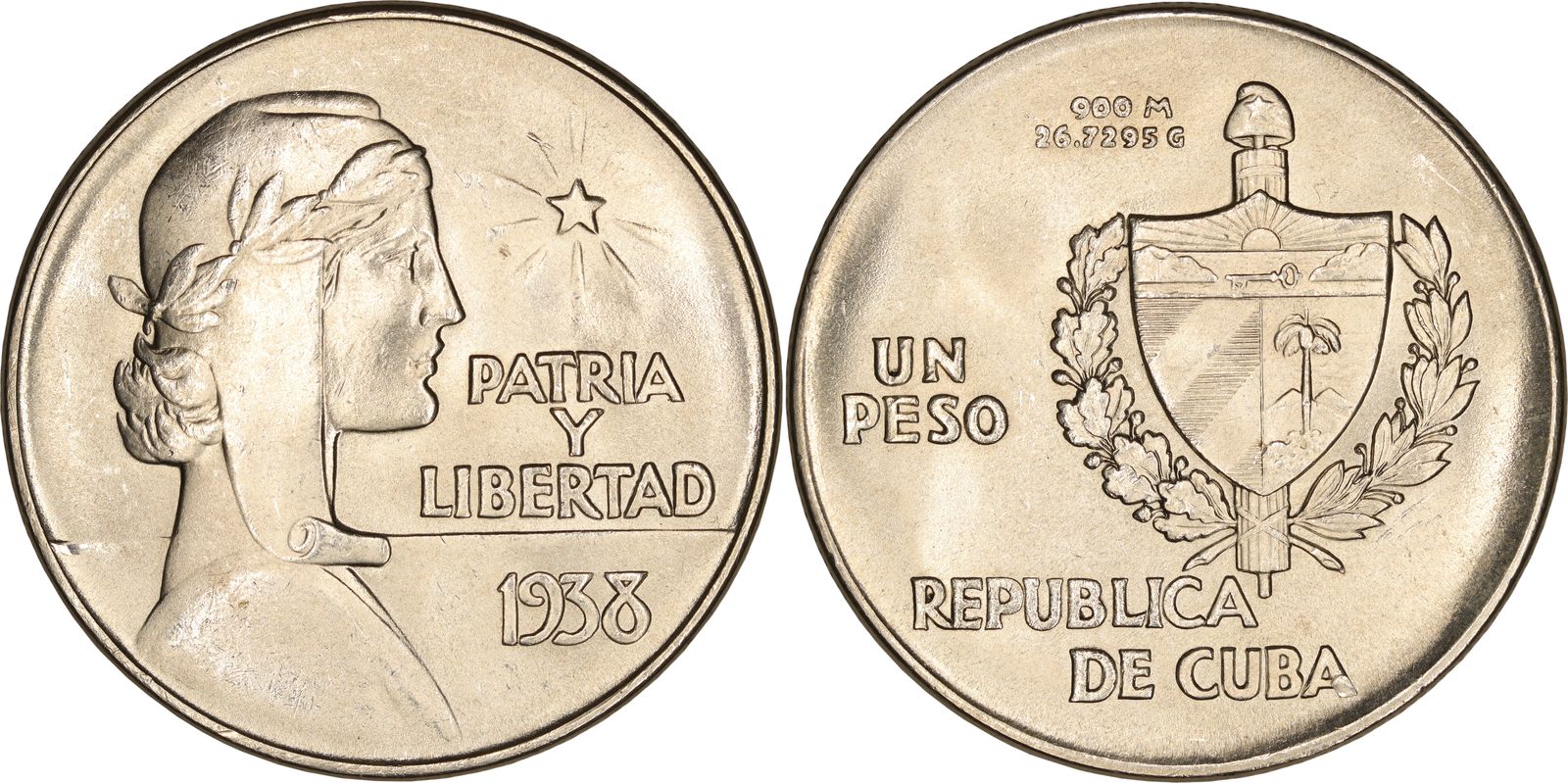
Cuba, Silver Peso (26.83g, 38mm) dated 1938, ‘ABC’ Type, minted at Philadelphia, USA. Obverse: Coat of Arms of Cuba, face value “UN PESO” to left field, fineness and weight “900M 26.7295 G” above, “REPUBLICA DE CUBA” below. Reverse: Figure of ‘The Republic’ facing to right, star in upper right field, legend to lower right, “PATRIA Y LIBERTAD 1938”. KM-22. Choice Uncirculated.

British India, King Edward VII (1902-1910 AD), Silver Proof Rupee dated 1909B, coined at the Bombay Mint. Obverse: Bare Head of King and Emperor Edward VII facing right, “EDWARD VII KING & EMPEROR”. Reverse: Denomination in English and Urdu with the date “1909” below, spray of lotus flowers on either side and a crown above, “ONE RUPEE INDIA ک روپیہ”(In Urdu: “Yek rupiya” = One rupee). Stv&W-7.48. Certified and Graded by PCGS as Proof 61 (#38597728). Proof aFDC and extremely rare.
An exceptional rarity of British India seldom seen on the numismatic market, most certainly a captivating type that commands a high degree of collectability with a corresponding premium price.


Leave a Reply
Want to join the discussion?Feel free to contribute!